<< Previous | Displaying results 5751-5800 of 6769 for "" | Next >>
Jewish deportees marching down a main street of Koszeg during the deportation of Hungarian Jews. Koszeg, Hungary, May 1944.
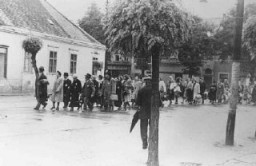
A deserted street in the area of the Sighet Marmatiei ghetto. This photograph was taken after the deportation of the ghetto population. Sighet Marmatiei, Hungary, May 1944.
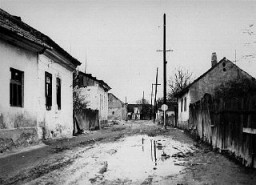
Street scene in the Jewish quarter of Paris before World War II and the Holocaust. Paris, France, 1933–39.
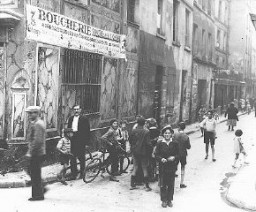
Foreign Jews arrested in Paris at the Austerlitz train station before deportation to the French-administered internment camps Pithiviers and Beaune-la-Rolande in the Loire region. Paris, France, ca. May 1941.
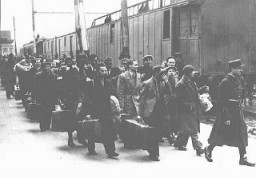
Lion Feuchtwanger (1884–1958), German-Jewish novelist, playwright, essayist, during his internment in the Les Milles camp. Les Milles, France, 1940.
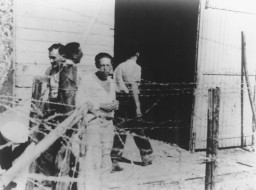
French government announcement concerning antisemitic legislation. Paris, France, December 10, 1941.
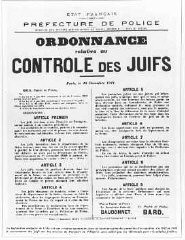
"Aryanization" in France: this shop, belonging to Jews, has been given to a non-Jewish "temporary administrator." Paris, April 1942.
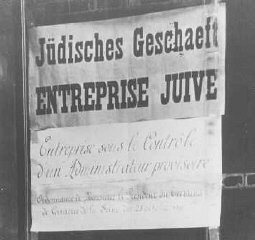
Identification card of Berthe Levy Cahen, issued by the French police in Lyon, stamped "Juif" ("Jew"). France, August 7, 1942.
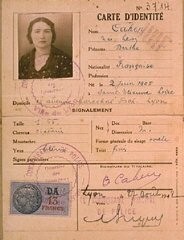
In German-occupied Paris, the fence around a children's public playground bears a sign forbidding entrance to Jews. Paris, France, November 1942.
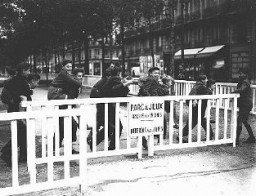
A group of Jewish women in Paris. They are wearing the required yellow badges. Paris, France, June 8, 1942.
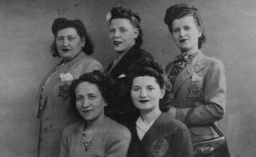
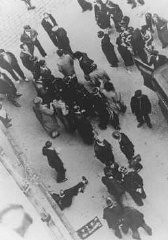
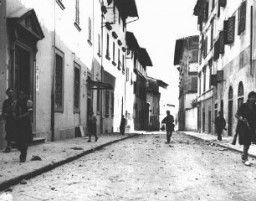
During the battle to liberate the French capital, a barricade is hastily built near the cathedral of Notre Dame. Paris, France, August 1944.
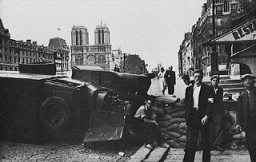
French General Charles de Gaulle and resistance leader Georges Bidault confer before marching down the Champs-Elysees to Notre Dame in ceremonies marking the liberation of the French capital. Paris, France, August 1944.
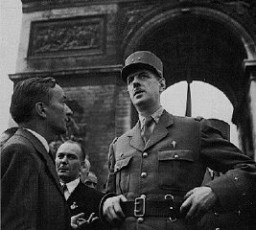
Shoshane Varmel Levy and her son, Jules, wearing the compulsory yellow badge, on a street in Antwerp. Belgium, June 1942.
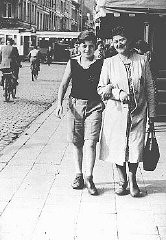
Three SS officers at the Breendonk internment camp: from left, First Lieutenant Hans Kantschuster, Master Sergeant Walter Mueller, and Second Lieutenant Artur Prauss. Breendonk, Belgium, between 1940 and 1944.
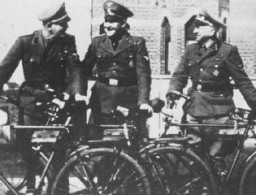
A Jewish child, Jacky Borzykowski, with the priest who placed him in hiding on a farm. Belgium, 1943.
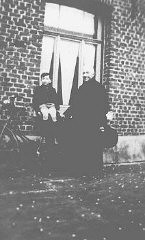
The Anciaux family with Annie and Charles Klein (front), Jewish children whom they sheltered during the war. Brussels, Belgium, between 1943 and 1945. Carle Enelow and Yettanda Stewart (born Charles and Annie Klein) were Jewish siblings who were hidden during the war by the family of Emile Anciaux, a Belgian Catholic. Charles and Annie's parents were deported from Mechelen (Malines) to Auschwitz, where they were murdered (their father on October 31, 1942, and their mother on January 15, 1944). After the…
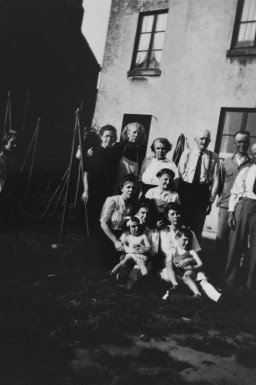
Portrait of Mother Superior Alfonse, who hid Jewish children from the Nazis in the Dominican Convent of Lubbeek near Hasselt. Yad Vashem recognized her as Righteous Among the Nations. Belgium, wartime
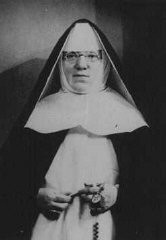
Karl-Heinz Kusserow, a Jehovah's witness who was imprisoned by the Nazis because of his beliefs. He was a prisoner in the Dachau and Sachsenhausen concentration camps in Germany.
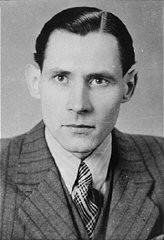
German forces during the military assault on Rotterdam during the Western Campaign. Rotterdam, the Netherlands, May 1940.
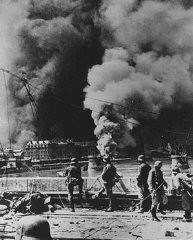
Austrian Nazi Arthur Seyss-Inquart. After the German invasion of the Netherlands in May 1940, a civil administration was installed under SS auspices. Seyss-Inquart was appointed Reich Commissar.
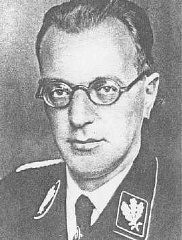
German police round up Jews in the Jewish quarter of Amsterdam, blockaded following anti-Nazi violence. Amsterdam, the Netherlands, February 22, 1941.
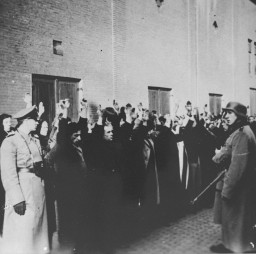
Members of the paramilitary organization of the Dutch Nazi Party stand in the doorway of a restaurant. The sign states "Jews are not desired." Amsterdam, the Netherlands, 1941–42.
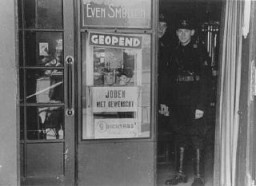
View of the Vught transit camp. Vught, the Netherlands, after September 9, 1944.
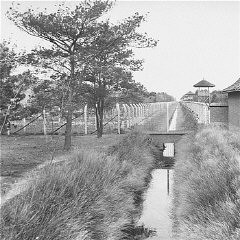
A Polish town lies in ruins following the German invasion of Poland, which began on September 1, 1939.
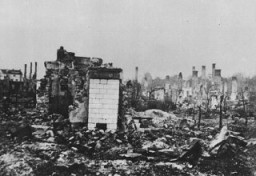
German troops arriving in Norway by ship prepare for landing during the German invasion of Norway. May 3, 1940.
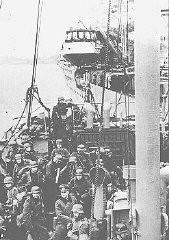
German troops disembarking from a troop transport during the German invasion of Norway. May 3, 1940.

German troops and planes on an improvised airfield during the battle for Norway, May 3, 1940.
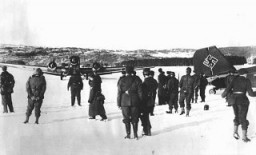
German troops during the invasion of Yugoslavia, which began on April 6, 1941.
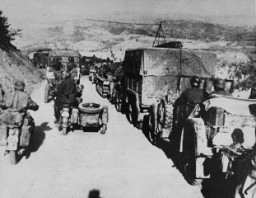
German Stuka dive-bombers fly over Yugoslavia during the German invasion of Yugoslavia, which began on April 6, 1941. Yugoslavia, ca. April 6, 1941.
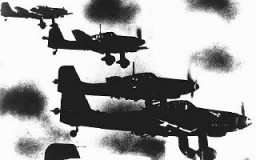
SS troops advance during the invasion of Greece. The invasion of the Balkans began in April 1941. Greece, wartime.

Antisemitic graffiti on Jewish-owned businesses on a Danzig street in 1935. The local Nazi Party had dominated the Danzig Senate since 1933. Danzig, 1935.
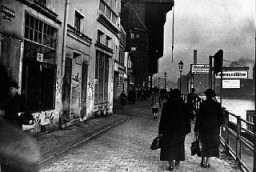
A young man looks at the antisemitic caricature in the display window of the Danzig office of "Der Stürmer." The poster reads: "The Jews are our misfortune." Danzig, 1939.
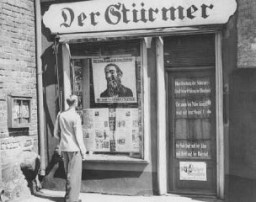
Antisemitic graffiti on a Jewish-owned shop that has been forced to close. Danzig, 1939.
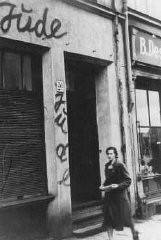
Saluting Germans greet Adolf Hitler (standing at front of car) as he enters Danzig. The Danzig District was incorporated into Greater Germany following the invasion of Poland. Danzig, September 19, 1939.

Adolf Hitler addresses German officers after the occupation of Danzig. Even before the surrender of Poland, Hitler affirmed the incorporation of the Danzig District into the Greater German Reich. Danzig, September 19, 1939.

Members of the SA enter Danzig in 1939. Germany annexed most of western Poland and Danzig within weeks of the German invasion of Poland.
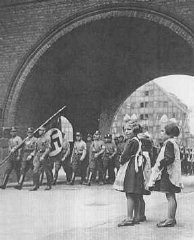
Arthur Greiser, a leading Nazi Party official in Danzig. He became the head of the Danzig Senate in 1934. After the beginning of World War II, he became administrator of the new province known as the Warthegau.
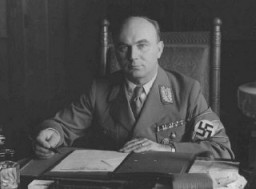
German forces enter Aachen, on the border with Belgium, following the remilitarization of the Rhineland. Aachen, Germany, March 18, 1936.
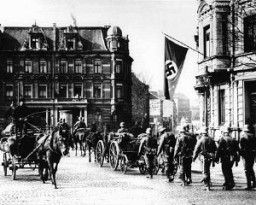
Members of the League of German Girls wave Nazi flags in support of the German annexation of Austria. Vienna, Austria, March 1938.
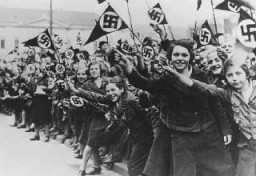
A streetcar decorated with swastikas passes billboards displaying Hitler's face. The billboards urge Austrians to vote "Ja" (Yes) in the upcoming plebiscite on the German annexation of Austria. Vienna, Austria, April 1938.
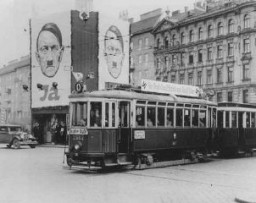
Scene during Adolf Hitler's triumphant return to Berlin shortly after Germany's annexation of Austria (the Anschluss). Berlin, Germany, March 17, 1938.
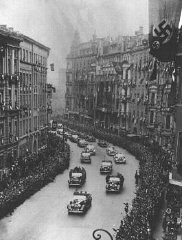
Hitler addresses German troops at the market square in Eger, during the German occupation of Czechoslovakia's Sudetenland region. October 3, 1938.
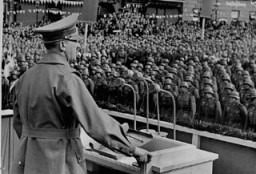
German tanks cross the Czech border, in violation of the 1938 Munich agreement. Pohorelice, Czechoslovakia, March 15, 1939.
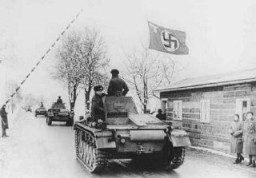

German occupation troops march through the streets of Prague. Czechoslovakia, March 15, 1939.
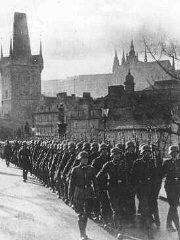
Adolf Hitler in Brno shortly after German troops occupied Czechoslovakia. The sign reads, "We thank our Führer." Brno, Czechoslovakia, March 17, 1939.
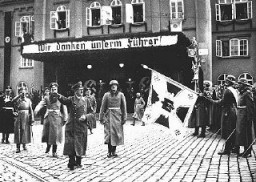
Hitler enters Memel following the German annexation of Memel from Lithuania. The banner states that "This land will remain forever German." Memel, March 1939.
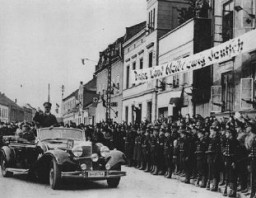
Jewish parachutist Hannah Szenes at Kibbutz Sedot Yam, a communal agricultural settlement. Palestine, 1942.
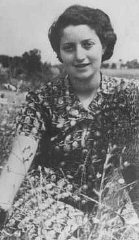
We would like to thank Crown Family Philanthropies, Abe and Ida Cooper Foundation, the Claims Conference, EVZ, and BMF for supporting the ongoing work to create content and resources for the Holocaust Encyclopedia. View the list of donor acknowledgement.